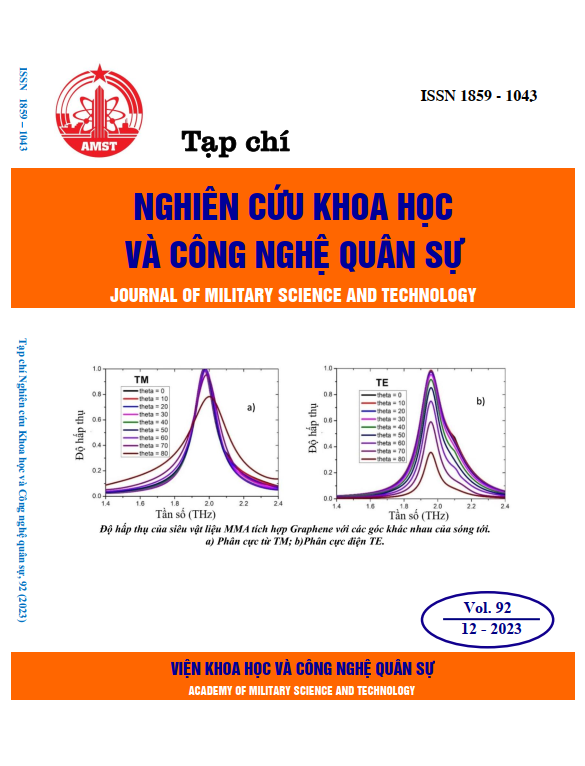Synthesis and study of optical properties of ZnTe/ZnSe core/shell and ZnTe/ZnSe/ZnS core/shell/shell semiconductor nanocrystals
432 viewsDOI:
https://doi.org/10.54939/1859-1043.j.mst.92.2023.114-120Keywords:
Nanocrystals; ZnTe/ZnSe; Optical properties; Excitation power.Abstract
ZnTe/ZnSe core/shell and ZnTe/ZnSe/ZnS core/shell/shell semiconductor nanocrystals (NCs) have been successfully fabricated by wet chemicals in an ODE solvent. The crystal structure, phonon characteristics and optical properties of the NCs were investigated using X-ray diffraction (XRD), Raman scattering (RS), photoluminescence (PL) spectroscopy, PL decay time, and absorption spectrum (Abs). The growth of ZnSe shell on ZnTe core and ZnS shell on ZnTe/ZnSe core/shell is demonstrated through XRD and RS. Observation results from XRD diagram show that all fabricated NCs are crystallized in cubic structure. The ZnS shell significantly enhanced the quantum yield (QY) of the ZnTe/ZnSe NCs. The effect of excitation power on the emission properties of ZnTe, ZnTe/ZnSe and ZnTe/ZnSe/ZnS NCs has been studied and explained in detail.
References
[1]. A. Sadao, “Properties of Semiconductor Alloys: Group-IV, III-V and II-VI Semiconductors”, New Jersey, Wiley, (2009).
[2]. V. V. Prokopiv, B. S. Dzundza, S. V. Sharyn, L. V. Turovska, O. M. Matkivskyi, “Electrical properties of cadmium telluride thin films doped with calcium and lithium”, Phys. Chem. Solid State, Vol. 21, pp. 232–237, (2020). DOI: https://doi.org/10.15330/pcss.21.2.232-237
[3]. N. X. Ca, N. T. Hien. et al, “Optical and Ferromagnetic Properties of Ni-Doped CdTeSe Quantum Dots”, J. Electron. Mater, Vol. 48, pp. 2593–2599, (2019). DOI: https://doi.org/10.1007/s11664-019-07017-9
[4]. H. T. Van, N. D. Vinh, P. M. Tan, U. T. D. Thuy, N. X. Ca, N. T. Hien, “Synthesis and optical properties of tunable dual emission copper doped CdTe1-xSex alloy nanocrystals”, Optical Materials, Vol. 97, pp.109392, (2019). DOI: https://doi.org/10.1016/j.optmat.2019.109392
[5]. M. M. Tan, Y. Yu, H. S. Lee, “Energy separation and carrier-phonon scattering in CdZnTe/ZnTe quantum dots on Si substrate”, Journal of Alloys and Compounds, Vol. 658, pp. 71-75, (2016). DOI: https://doi.org/10.1016/j.jallcom.2015.10.226
[6]. M. Masab, H. Muhammad, F. Shah, M. Yasir, M. Hanif, “Facile synthesis of CdZnS QDs: Effects of different capping agents on the photoluminescence properties”, Materials Science in Semiconductor Processing, Vol. 81, pp. 113-117, (2018). DOI: https://doi.org/10.1016/j.mssp.2018.03.023
[7]. V. T. K. Lien, P. M. Tan, N. T. Hien, V. X. Hoa, T. T. K. Chi, N. X. Truong, V. T. K. Oanh, N. T. M. Thuy, N. X. Ca, “Tunable photoluminescent Cu-doped CdS/ZnSe type-II core/shell quantum dots”, Journal of Luminescence, Vol. 215, pp. 116627, (2019). DOI: https://doi.org/10.1016/j.jlumin.2019.116627
[8]. N. T. Hien, T. T. K. Chi, N. D. Vinh, H. T. Van, L. D. Thanh, P. V. Do, V. P. Tuyen, N. X. Ca, “Synthesis, characterization and the photoinduced electron-transfer energetics of CdTe/CdSe type-II core/shell quantum dots”, Journal of Luminescence, Vol. 217, pp. 116822, (2020). DOI: https://doi.org/10.1016/j.jlumin.2019.116822
[9]. N. X. Ca, N. T. Hien, N. T. Luyen, V. T. K. Lien, L. D. Thanh, P. V. Do, N. Q. Bau, T. T. Pham, “Photoluminescence properties of CdTe/CdTeSe/CdSe core/alloyed/shell type-II quantum dots”, Journal of Alloys and Compounds, Vol. 787, pp. 823-830, (2019). DOI: https://doi.org/10.1016/j.jallcom.2019.02.139
[10]. M. F. Ehsan et al, “ZnTe/ZnSe heterostructures: In-situ synthesis, characterization and photocatalytic activity for Congo Red degradation”, SN Appl. Sci, Vol. 1, pp. 197, (2019). DOI: https://doi.org/10.1007/s42452-019-0220-2
[11]. T. A. Saleh, “Chapter 7 - Structural characterization of hybrid materials, Polymer Hybrid Materials and Nanocomposites”, William Andrew Publishing, pp. 213-240, (2021). DOI: https://doi.org/10.1016/B978-0-12-813294-4.00005-4
[12]. U. Hotje, C. Rose, M. Binnewies, “Lattice constants and molar volume in the system ZnS, ZnSe, CdS, CdSe”, Solid State Sciences, Vol. 5, pp. 1259-1262, (2003). DOI: https://doi.org/10.1016/S1293-2558(03)00177-8
[13]. R. Zarei et al., “An investigation on structural and optical properties of nanocolumnar ZnTe thin films grown by glancing angle technique”, Mater. Res. Express, Vol. 7, pp. 026419, (2020). DOI: https://doi.org/10.1088/2053-1591/ab7691
[14]. S. Adachi, “Cubic Zinc Sulphide (β-ZnS). In: Optical Constants of Crystalline and Amorphous Semiconductors”, Springer, Boston, MA. (1999), https://doi.org/10.1007/978-1-4615-5247-534. DOI: https://doi.org/10.1007/978-1-4615-5247-5_34
[15]. W. Szuszkiewicz et al., “Raman spectroscopy of MBE-grown ZnTe and Zn1-xMnxTe nanowires”, Journal of Physics: Conference Series, Vol. 92, pp. 012040, (2007). DOI: https://doi.org/10.1088/1742-6596/92/1/012040
[16]. F. A. Akgul et al., “Improved diode properties in zinc telluride thin film-silicon nanowire heterojunctions”, Philosophical Magazine, Vol. 95, pp. 1164-1183, (2015). DOI: https://doi.org/10.1080/14786435.2015.1026296
[17]. Guan et al., “Exciton-longitudinal optical phonon coupling in a ZnSe–Zn0.75Cd0.25Se double-superlattice at 1.4K”, Solid State Communications, Vol. 111, pp. 241-245, (1999). DOI: https://doi.org/10.1016/S0038-1098(99)00198-2
[18]. U. P. Gawai, U. P. Deshpande, B. N. Dole, “A study on the synthesis, longitudinal optical phonon- lasmon coupling and electronic structure of Al doped ZnS nanorods”, RSC Adv, Vol. 7, pp. 12382-12390, (2017). DOI: https://doi.org/10.1039/C6RA28180J
[19]. M. Slyotov, T. Mazur, V. Prokopiv, O. Slyotov, M. Mazur, “Sources of optical radiation based on ZnTe/ZnSe/ZnS heterostructures”, Materials Today: Proceedings, Vol. 62, pp. 5763–5766, (2022). DOI: https://doi.org/10.1016/j.matpr.2022.03.476
[20]. J. Z. Niu et al., “Controlled synthesis of high quality type-II/type-I CdS/ZnSe/ZnS core/shell1/shell2 nanocrystals”, Dalton Trans, Vol. 39, pp. 3308-3314, (2010). DOI: https://doi.org/10.1039/b922130a
[21]. R. Zeng et al., “Aqueous synthesis of type-II CdTe/CdSe core–shell quantum dots for fluorescent probe labeling tumor cells”, Nanotechnology. 20, 095102, (2009). DOI: https://doi.org/10.1088/0957-4484/20/9/095102
[22]. K. Boldt et al., “Electronic Structure Engineering in ZnSe/CdS Type-II Nanoparticles by Interface Alloying”, J. Phys. Chem. C, Vol. 118, pp. 13276, (2014). DOI: https://doi.org/10.1021/jp503609f
[23]. L. W. Zhang et al., “Oxidative dissolution of polymer-coated CdSe/ZnS quantum dots under UV irradiation: Mechanisms and kinetics”, Environmental Pollution, Vol. 164, pp. 259-266, (2012). DOI: https://doi.org/10.1016/j.envpol.2012.01.047
[24]. D. F. Fanga, Z. M. Zhang, Z. P. Wang, Z. J. Ding, “Study of Photoluminescence of CdS/ZnS Core/Shell Quantum Dots”, Physics Procedia, Vol. 32, pp. 920 – 925, ( 2012 ). DOI: https://doi.org/10.1016/j.phpro.2012.03.657
[25]. I. P. Seetoh, C. B. Soh, E. A. Fitzgerald, S. Chua, “Auger recombination as the dominant recombination process in indium nitride at low temperatures during steady-state photoluminescence”, J. Appl. Phys. Lett, Vol. 102, pp. 101112, (2013). DOI: https://doi.org/10.1063/1.4795793
[26]. C. H. Wang et al., “Photoluminescence properties of CdTe∕CdSeCdTe∕CdSe core-shell type-II quantum dots”, J. Appl. Phys, Vol. 99, pp. 123521, (2006). DOI: https://doi.org/10.1063/1.2207721
[27]. Y. Sun, C. Qian et al., “Recombination processes in CuInS2/ZnS nanocrystals during steady-state photoluminescence”, Appl. Phys. Lett, Vol. 08, pp. 041106, (2016). DOI: https://doi.org/10.1063/1.4941028







